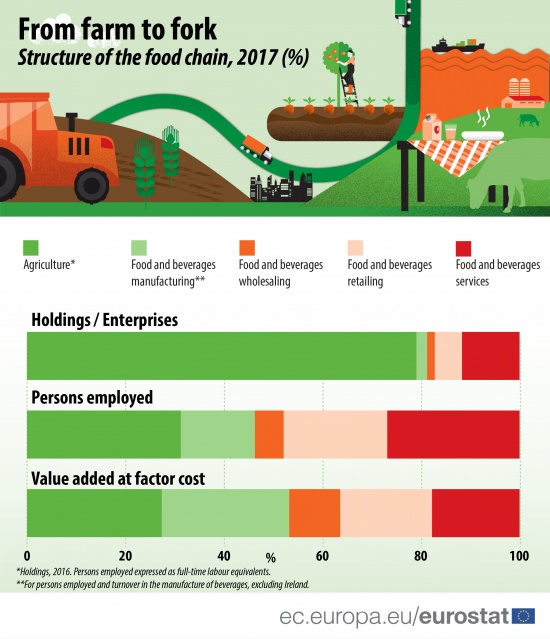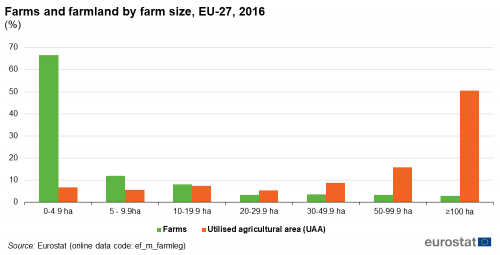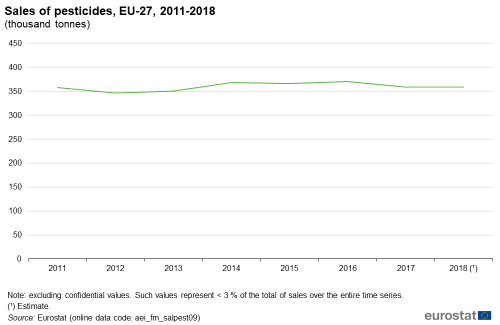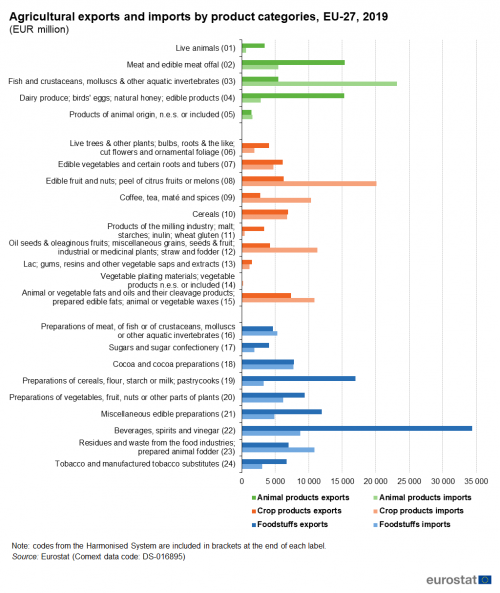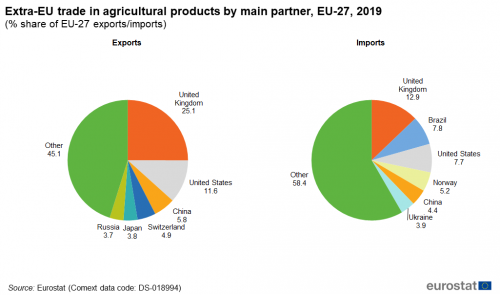Archive:From farm to fork - a statistical journey
This article is outdated and has been archived. For recent articles on Agriculture, see here.
Data extracted in April 2020.
Highlights
10.3 million agricultural holdings in the EU farming 156.7 million hectares of land.
Around 280 000 enterprises across the EU manufacture food and beverages.
About 920 000 enterprises in the EU are food and beverages wholesalers and retailers.
This article sheds a statistical light on the distinct stages that take raw products from farms and the sea, and through processing and then distribution deliver food and beverages to our tables. These are the key parts of the chain that are most closely linked to the longer-term Farm to Fork strategy of the European Union.
The presentation of the four key stages in the Farm to Fork chain is kept simplified in order to provide a general overview and focus is given to the main stages of the chain linked to the Farm to Fork strategy. Important upstream activities and businesses that are fundamental for farms are not covered: these include manufacturers and suppliers of farming tools, of machinery, and of inputs such as feed, fertilisers and pesticides.
The analysis also highlights how vulnerable the chain is to disruptions, such as the COVID-19 pandemic. Collection and delivery of goods between stages is crucial for the function of the chain as a whole. Disruption can come in any or all of the key stages of the chain, such as: a lack of seasonal workers at harvest times; disruptions in the transport network making deliveries from farms to processors (including slaughterhouses and dairies) or from manufacturers to retailers; and, the closure of restaurants and bars. The impact of COVID-19 is not something that is possible to tackle in this article, separate news items will look at the possible impact in specific areas.
Full article
Farm production stage
Farming is an activity that is about growing crops and raising livestock. It builds upon a variety of natural, biological processes particularly regarding the soil. It is the business of providing key primary ingredients for the food that we eat and much of what we drink. Farming draws on a set of resources to produce these agricultural goods, as well as agricultural services.
Many of these inputs and resources come from upstream activities and businesses that are not explicitly analysed here. The farming sector buys machinery, seeds, fertilisers, pesticides and other inputs to produce raw agricultural goods. These upstream businesses are as dependent on farming as farming is on them.
Understanding how much of these resources are being used and what is being produced with a given set of resources provides a key insight into how agriculture in the EU will meet the challenges of the European Green Deal.
Farms and farmland
There were 10.3 million agricultural holdings in the European Union (EU) of 27 Member States in 2016 - the latest year for which structural data are available - farming 156.7 million hectares of land. One third (33.3 %) of the EU’s agricultural holdings (termed ‘farms’) were located in Romania, with a further quarter together found in Poland (13.7 %) and Italy (11.1 %).
The overwhelming majority (96.3 %) of the EU’s farms are family farms - for more information see this article. Most of the EU’s farms are also small in nature; two-thirds (66.6 %) were smaller than 5 hectares (ha) in size in 2016. Although the average mean size of a farm in the EU was 15.2 ha in 2016, only about 17 % of farms were this size or larger.
EU farms can be broadly characterised as either (i) linked to semi-subsistence households (ii) small and medium-sized farms or (iii) large agricultural enterprises. The smallest 7.0 million farms in the EU (68.3 % of all farms), with an economic size in terms of standard output below EUR 8 000 per year, were responsible for a little less than 5 % of the EU’s total agricultural economic output. In contrast, the largest 278 000 farms in the EU (just 2.7 % of the total) that each had an annual standard output above EUR 250 000 for the 2016 year were responsible for a majority (54.4 %) of total agricultural economic output.
EU farms remain diverse in terms of what they grow or rear. About one half (52.9 %) of all farms in 2016 could be categorised as being crop specialist farms. In more detail, just under one-third (31.7 %) of all farms were specialised in field cropping, about one fifth (19.3 %) were specialised in permanent crops, with the remainder (1.8 %) being specialist horticultural farms. For more information see this article.
Another one quarter (24.5 %) of the EU's farms were specialist livestock farms, with sheep, goats and other grazing livestock farms (5.7 %) and specialist dairy farms (5.4 %) the most numerous within this grouping. Mixed farms accounted for most other types of farms (21.4 %). There were a small percentage of farms that could not be classified.
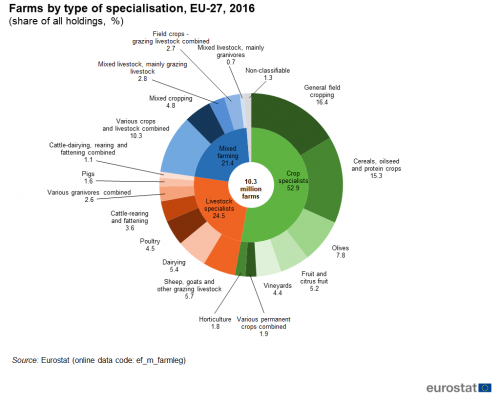
(share of all holdings, %)
Source: Eurostat (ef_m_farmleg)
EU farms used 156.7 million hectares (ha) of land for agricultural production in 2016. A little over two-thirds (68.5 %) of the utilised agricultural area of the EU was based in just six Member States; France used 27.8 million ha for agricultural purposes in 2016, Spain 23.2 million ha, Germany 16.7 million ha, Poland 14.4 million ha, Italy a further 12.6 million ha and Romania 12.5 million ha.
Farms managed 37.2 % of the total land area of the EU-27 in 2016 and they also managed 6.4 % of wooded areas. Of the land used for agricultural production in the EU, the vast majority (62.0 % in 2016) was arable land which was mainly used to produce crops for human and animal consumption. Permanent grassland accounted for a further one-third (31.2 %) of the utilised agricultural area, and was mainly used to provide further fodder and forage for animals. The remaining area (5.5 %) was used for permanent crops such as fruit, olives and grape production.
Organic farming
Organic farming is an agricultural method that aims to produce food using natural substances and processes. EU regulations on organic farming are designed to provide a clear structure for the production of organic goods across the whole of the EU.
About one quarter of a million holdings in the EU have some organic area; this number is increasing. For more information see this article. There were about 244 000 agricultural holdings (here termed ‘farms’) in the EU that had some organic area in 2016. This number was about one-fifth higher than in 2013. A two-thirds (68.2 %) majority of farms in the EU with some organic area were fully organic in 2016, the remaining one third having a mixture of organic and non-organic production.
Organic farming covered a provisional 13.0 million hectares of agricultural land in the EU in 2018, corresponding to an estimated 8.3 % of the total utilised agricultural area. The total organic area is the sum of the "area under conversion" and the "certified area". Before an area can be certified as "organic", it must undergo a conversion process, which may take 2-3 years depending on the crop.
A small majority of the EU’s total organic area was located in just four Member States: Spain (17.3 %), France (15.7 %), Italy (15.1 %) and Germany (9.4 %). This was a higher collective proportion (57.5 %) than the four Member States' share (51.3 % in 2016) of the total utilised agricultural area.
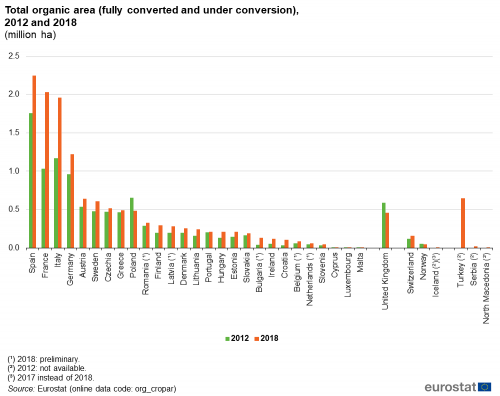
(million ha)
Source: Eurostat (org_cropar)
Farmers
Agriculture remains a big employer within the EU; the equivalent of an estimated 8.8 million people worked full-time in agriculture in 2019. People working in agriculture (and hunting) accounted for an estimated 4.5 % of total employment in the EU in 2017. Agriculture is a particularly big employer in Romania, accounting for a little less than one in every four persons (22.8 %).
Farms managers are typically male and relatively old. Seven in every ten (71.2 %) farm managers in the EU in 2016 were male and a majority (57.8 %) of all farm managers were 55 years of age or more. Only about one in every ten (10.7 %) farm managers was a young farmer under the age of 40 years. This top-heavy age structure underlines the policy interest in farm succession and the need to encourage a new generation of farmers.
Elderly farm managers tend to work on the smallest farms (measured in economic terms); four-fifths (82.7 %) of the EU's farm managers that were 65 years of age or older worked on subsistence farms and very small farms in 2016 with a standard output below EUR 8 000 per year.
Very few farm managers in the EU have full agricultural training. Most farm managers in the EU only have practical experience; this was the case for seven in every ten (68.3 %) farm managers in 2016. Less than one in ten (8.9 %) farm managers had full agricultural training, and the rest (22.7 %) had basic agricultural training.
Farm production
So what do EU farms produce?
Despite the drought conditions in central and northern Europe and the wet conditions across much of southern Europe during the 2018 crop year, the EU remained a key global producer of crops. The EU-27’s farms produced 274.3 million tonnes of cereals, about 13 % of global production, although this was 34.0 million tonnes less than the relative peak in 2014. The main cereals are common wheat and spelt (115.6 million tonnes in 2018), grain maize and corn-cob-mix (69.0 million tonnes), barley (50.2 million tonnes), oats (7.0 million tonnes) and rye and maslin (6.5 million tonnes). These grains may be used to manufacture food that people eat directly or may be used to feed livestock, or manufacture a wide range of products from alcohols to cosmetics.
The EU is the world’s leading producer of sugar beet, the 111.9 million tonnes produced in 2018 accounting for about one half of global production. However, only about one-fifth of the world’s sugar comes from sugar beet, the rest coming from sugar cane. The EU also produced 46.8 million tonnes of potatoes. Sugars are used in a wide range of foods as preservatives, to add sweetness, coatings, volume and texture. They are also used in a wide range of health and beauty, home and garden and industrial products. Potatoes are also used in a wide range of food products, as well as alcohols, as fodder for livestock and as a thickener and binder in sauces, among other things.
The EU’s farms also produced a wide range of other crops including 32.0 million tonnes of oilseeds, 61.0 million tonnes of fresh vegetables (including melons and strawberries), 11.1 million tonnes of citrus fruit, 26.2 million tonnes of grapes, 13.7 million tonnes of olives and 27.6 million tonnes of other fruit, nuts and berries in 2018.
As well as crops, the EU’s farms reared animals for meat and dairy products. Among the principal meats, EU farms produced 22.9 million tonnes of pigmeat, 13.2 million tonnes of chicken and 6.0 million tonnes of beef in 2018. In addition, EU farms produced 156.6 million tonnes of milk, of which 144.8.0 million tonnes of milk were collected by dairies and 11.8 million tonnes were used on farms directly.
What is all this production worth to the economy? The value of everything that the EU-27's agricultural sector produced in 2018 was an estimated EUR 404.7 billion; this includes the value of crops, of animals, of agricultural services as well as of some goods and services that were not strictly agricultural but which could not be separately measured.
About one half (53.0 %) of the value of the total output of the EU's agricultural industry[1] in 2018 came from crops (EUR 214.4 billion), within which vegetables and horticultural plants and cereals were the most valuable. A further two-fifths (38.5 %) came from animals and animal products (EUR 155.8 billion), a majority coming from just milk and pigs. Agricultural services (EUR 19.5 billion) and inseparable non-agricultural activities (EUR 15.1 billion) contributed the rest (8.5 %).
Contributions from Member States varied significantly, reflecting differences in volumes produced, prices received as well as the mix of crops grown, animals reared, animal products collected and services offered. Well over one half (59.0 %) of the total output value of the EU's agricultural industry came from the 'big four' of France (EUR 77.2 billion), Italy (EUR 56.9 billion), Germany (EUR 52.7 billion) and Spain (EUR 52.2 billion).
Intermediate consumption goods and services
What inputs do farmers use? Producing all this output incurred costs. Farmers had to make purchases of goods and services to be used as inputs in the production process; they bought things like seeds, fertilisers, animal feedingstuffs and fuel for their tractors as well as veterinary services, among other things. These input costs are termed 'intermediate consumption' in an accounting context. Intermediate consumption costs for the agricultural industry came to a total of EUR 233.2 billion for the EU as a whole in 2018.
Some costs are associated with the farming of animals; they required feed, which accounted for over one third (37.7 %) of total intermediate consumption costs, and veterinary services (a further 2.6 %). Likewise, some costs are associated with crop farming; farmers required seeds and plants (5.1 % of total costs), many used plant protection products such as herbicides, insecticides and pesticides (4.8 %) and fertilisers and soil improvers (6.6 %). Other costs are common to all types of farm, independent of whether specialist or mixed-type.
Related datasets: Cereals, sugar beet and potatoes, meat, milk, values and output of the agriculture industry.
Pesticides and mineral fertilisers
There is particular interest in the use of pesticides and mineral fertilisers in agriculture. Sales of pesticides in the EU-27 were about 360 000 tonnes in 2018 and this was more or less unchanged in the period from 2011. For more information see this article. The consumption volume of mineral fertilisers, nitrogen (N) and phosphorus (P), by agriculture remained high in the period 2007 to 2018; an estimated 11.3 million tonnes were used in 2018. For more information see this article.
When the nutrients used in agriculture are not absorbed by crops their use is considered excessive and is linked to environmental issues regarding water pollution, the climate[2] and reduced biodiversity. The gross nitrogen balance (GNB) provides an indication of the potential surplus of nitrogen (N) on agricultural land (kg N per ha per year). The gross nitrogen balance for the EU-27 decreased from an estimated average of 51 kg N per ha per year in the period 2004-2006 to 47 kg N per ha per year in the period 2013-2015. For more information see this article. Mineral fertilisers accounted for 45 % of the nitrogen input in the EU in 2014, manure accounting for another 38 %.
The gross phosphorus balance provides insight into links between agricultural phosphorus use, losses of phosphorus to the environment, and the sustainable use of soil nutrient resources. A persistent surplus indicates potential environmental problems, such as phosphorus leaching resulting in pollution of drinking water and eutrophication of surface waters. A persistent deficit can impair the resource sustainability of agriculture soil through soil degradation, or soil mining, resulting in declining fertility in areas under crop or forage production. The gross phosphorus balance for the EU was 1.2 kg per hectare per year in the period 2013-2015, down from 3.9 kg per hectare per year in the period 2004-2006. This means that although there remains an annual surplus, the size of this annual surplus has declined; in the period between 2013-2015 it was about 30 % of what it was in the early 2000s.For more information see this article.
Economic performance
How does this translate into the economic performance of agriculture in the EU? The gross value added by the EU’s agricultural industry, which is the difference between the value of everything that the EU’s primary agricultural sector produced in 2018 and the costs of the services and goods used in the production process, was an estimated EUR 171.5 billion in 2018. One way of looking at this is that for every 1 euro spent on the cost of goods and services used in the production process (known as intermediate consumption), the agricultural industry created added value of EUR 0.74.
Agricultural production in the EU by the millions of predominantly small farms adds up to being big business, even without considering its importance as the key building block for the downstream food and beverages processing industry. The agricultural sector contributed 1.2 % to the EU-27's GDP in 2018. To put this in some context, the contribution of agriculture to the EU's economy was only slightly less than the GDP of Greece in 2018, the seventeenth largest economy among the Member States.
One way in which the performance of the agricultural industry can be measured is the net value added at factor cost for the equivalent of each full-time worker (measured in Annual Work Units) in the agricultural industry. Agricultural income per AWU for the EU as a whole in 2018 fell back (3.5 %) from the high recorded in 2017. Nevertheless, it remained about one fifth higher (+21.5 %) than the level in 2010.
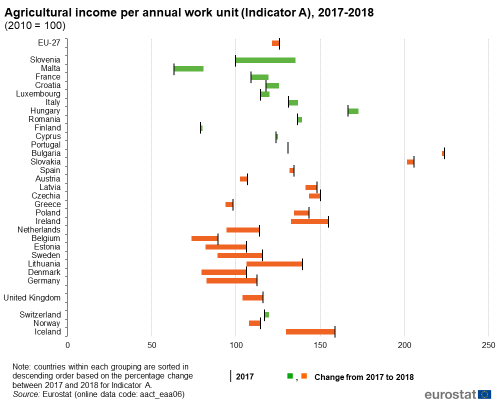
(2010 = 100)
Source: Eurostat (aact_eaa06)
Fish production
In addition to the food that is grown or reared on farms, fish and other aquatic organisms are caught at sea or produced in aquafarms. EU Statistical Regulations on catching fish cover seven marine areas[3]; these are the north-east Atlantic; north-west Atlantic; Mediterranean and Black Sea; eastern-central Atlantic; south-east Atlantic; south-west Atlantic; and, western Indian Ocean, within each of which are a number of seas.
As a general rule, fishing vessels registered in the EU fishing fleet register have equal access to all the EU waters and resources that are managed under the Common Fisheries Policy (CFP). Access to fisheries is normally authorised through a fishing license. The seas resources for most commercial fish species are, however, limited through total allowable catches (TACs) that are set annually for various sea regions based on the scientific advice provided by advisory bodies like the International Council for the Exploration of the Sea (ICES) and the Scientific, Technical and Economic Committee for Fisheries (STECF)[4]. For 2018, the European Council agreed to increase or maintain the previous year’s catch limits for 53 stocks and reduce them for 25 stocks.
The fishing fleet and employment
The EU-27 fishing fleet continues to shrink. The number of active vessels registered in 2018 was 75 800, which had a combined capacity of 1.4 million gross tonnes and a total engine power of 5.4 million kilowatts (kW). Compared to 2008, the number of vessels was down 3.8 %, the overall gross tonnage was down 18.4 % and engine power was down 9.8 %.
The EU fleet is very diverse, with the vast majority of boats being no more than 10 metres long, and a small number of vessels exceeding 40 metres in length. The average size of an EU fishing boat in 2018 was 18 gross tonnes and the average engine power was 71.2 kW.
When measured by gross tonnage, Spain had by far the largest fishing fleet among Member States (24.4 % of the EU total). When measured by engine power, however, the largest fleet was that in France (17.9 % of the EU total), closely followed by that in Italy (17.2 %). When measured by the number of vessels, the largest fleet in the EU was in Greece (19.7 % of all vessels), followed by Italy (15.9 %). Greek vessels were small on average, however, with an average size of 4.8 gross tonnes, and an average engine power of 28.6 kW in 2018.
A provisional 166 600 people were employed in the EU’s primary fisheries industry in 2017, of which about one third were employed in the aquaculture sub-sector. About 41 000 people in Spain worked in the fishing industry in 2017, with a further 29 000 people in Italy, 21 000 people in Greece and 20 000 people in France.
Related datasets: Fishing fleet and employment in fishing and aquaculture.
Catches and aquaculture
The monitoring of catches and aquaculture production is an essential tool for securing fish stocks and sustaining the common resources available in Europe’s large and rich fishing areas.
The EU-27's total production of fishery products in 2017 was an estimated 5.7 million tonnes of live weight equivalent (the mass or weight when removed from water). Four-fifths (80.1 %) of total fisheries production came from catches (4.6 million tonnes), the remaining one-fifth coming from aquaculture (1.1 million).
About one half (48.8 %) of all EU fisheries production from catches and aquaculture came from just three Member States in 2017; these were Spain (17.9 %), Denmark (16.1 %) and France (14.7 %). By way of comparison, it is interesting to note that total fisheries production in Norway (3.5 million tonnes of live weight in 2017) was about 60 % of that of the EU as a whole and in Iceland (1.2 million tonnes in 2017) was almost as big as in Spain, the EU's biggest fisheries producer.
The total EU-27 catch in 2018 was an estimated 4.6 million tonnes live weight, a similar level to that in 2017. However, it remained much lower than that at the turn of the Millennium (1.3 million tonnes less than the catch in 2001), although 0.8 million tonnes higher than the low point in 2012.
Although the European fishing fleet operates worldwide, about three-quarters of all EU catches were taken in the north-east Atlantic. The key species caught in north-east Atlantic were Atlantic herring, Atlantic mackerel, European sprat and Blue whiting.
In the Mediterranean and Black Sea about one-fifth of the total live-weight caught by the EU fishing fleet was sardines, with another one-fifth being anchovies. In the eastern-central Atlantic, the main catches were skipjack and yellowfin tuna, sardines and mackerel. In the western Indian Ocean, the main catch was tuna, whether skipjack, yellowfin or bigeye. To complete the overview of species by region, the main species caught in the south-west Atlantic were hake, other groundfish and squid, in the south-east Atlantic they were mackerel and skipjack tuna, and in the north-west Atlantic they were redfish, halibut and cod.
The EU produced an estimated 1.1 million tonnes of aquatic organisms (like molluscs and crustaceans) in 2017, corresponding to one-fifth of the output of European fisheries as a whole. In terms of output, the EU's aquaculture sector was the eighth largest worldwide, with a 1.6 % share of the volume of global output in 2016. The value of the EU's aquaculture production was an estimated EUR 5.1 billion in 2017, about two-fifths of the total value of the EU’s total production of fishery products.
Related datasets: Catches and aquaculture.
Generation of waste
The activities of agriculture, forestry and fishing generate a wide range of waste products, particularly as animal and vegetal wastes. These include slurry and manure, as well as various green wastes including biodegradable waste.
Agriculture, forestry and fishing in the EU-27 generated 20.3 million tonnes of waste in 2016, which represented 0.9 % of all the waste produced by economic activities and households in the EU. The vast majority of this waste (17.0 million tonnes) was animal and vegetal waste.
The quantity of animal and vegetal waste in 2016 was substantially less than the 57.3 million tonnes produced in 2004. However, the 2016 figure suggests a small upswing from the relative low of 14.5 million tonnes produced in 2012.
The main component of animal and vegetal waste produced by this sector of the economy was animal faeces, urine and manure. Farms produced 12.0 million tonnes of this type of waste in 2016, down sharply from the 30.9 million tonnes produced in 2004, although 2.3 million tonnes more than the relative low in 2012.
By weight, two-thirds of the EU’s animal faeces, urine and manure waste was produced in Spain (39.4 %) and the Netherlands (27.5 % of the EU total). However, whereas the level of this type of waste declined by 11.8 million tonnes between 2004 and 2016 in Spain, it increased by 2.7 million tonnes in the Netherlands during the same period.
Related dataset: Generation of waste.
Processing stage
The food system is much wider than primary agricultural production; it also covers food preparation and sales. Farming is the activity of growing, rearing and harvesting primary products. However, before food and beverages arrive on the table, they have often been processed, packaged, transported, distributed and marketed.
The EU’s Common Agricultural Policy (CAP) recognises these links with its aims to ‘ensure a stable supply of affordable food’, to ‘keep the rural economy alive by promoting jobs in farming, agri-foods industries and associated sectors’ and ‘to protect food and health quality’.
Much of the produce from the EU’s 10.3 million farms are sold on to the food and beverages industry for processing both within and outside the EU, with only some products like wine, olive oil and cheese being sometimes processed directly by farms or farmers' cooperatives.
In turn, the foods and beverages processing industry produces a range of products for final consumption or for use as intermediate products (like oils, fats and sugars) for further processing or transformation in other downstream manufacturing industries, before they are available to consumers.
Dairies and slaughterhouses
For animal food products, the first processing stage is at the dairy or in slaughterhouses. Dairy enterprises either purchase from milk collection centres or, more typically, directly from farms with a view to transforming them into milk products. Slaughterhouses in the EU are registered and approved establishments used for slaughtering and dressing animals, whose meat is intended for human consumption. Their activity is not normally considered as processing but, for a balanced overview, they are included in the analysis.
There were about 4 900 dairy enterprises across the EU-27 in 2018. A high proportion of these were in southern European Member States; Italy alone had almost 1 200 dairies and Greece about 800 dairies.
In most Member States, these dairies were relatively small, collecting less than 5 000 tonnes of milk per year. For example, almost three-quarters of dairies in Italy collected less than 5 000 tonnes of milk per year and about 94 % of all dairies in Greece. However, there are some exceptions. A few Member States had a small number of relatively large dairies that collected more than 100 000 tonnes of milk per year; this included about one-third of the 38 dairies in Ireland, about 40 % of the 30 dairies in the Netherlands and of the 14 dairies in Lithuania, and 46 % of the 115 dairies in Germany.
There has been considerable consolidation of the dairy market with the EU. For example, the number of dairy enterprises in Italy, France and Germany halved or more than halved in the period between 1994 and 2018.
Related dataset: Dairies.
Manufacture of food products and beverages
There were about 280 000 enterprises across the EU-27 that manufactured food and beverages in 2017. About one half (51.4 %) of these enterprises were involved in bakery and farinaceous products such as breads, cakes, biscuits, pastas and noodles. Enterprises producing meat and meat products, beverages and other food products like sugars and confectionery products, prepared meals and teas together accounted for about a further one third of food and beverages enterprises in 2017.
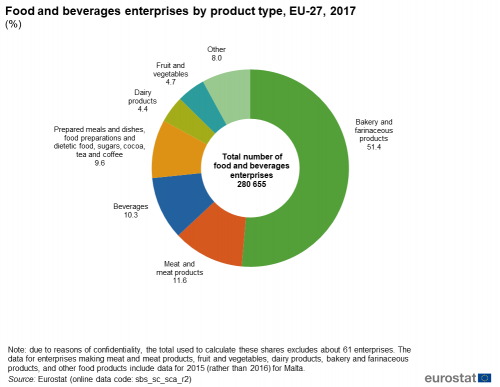
(%)
Source: Eurostat (sbs_sc_sca_r2)
Food and beverages enterprises provided employment to 4.4 million people in 2017. Food manufacturing enterprises had an estimated turnover of EUR 930 billion in 2017 and beverages enterprises for the 26 Member States for which data are available, a further EUR 151 billion of turnover.
France and Italy had the largest number of food and beverages enterprises, each accounting for about 20 % of the EU total. However, Germany employed the most people in this sector (20.3 % of the EU total), followed by France (16.1 %) and Italy (10.4 %).
The overwhelming majority (about 95 %) of all food and beverage enterprises in the EU were small in nature, employing less than 50 persons. Indeed, very small enterprises employing less than ten persons accounted for about 80 % of all food and beverages enterprises in 2017.
Medium-sized enterprises employing between 50 and 249 persons and large enterprises employing more than 250 persons together accounted for a minority of enterprises in all Member States; the highest shares were in Luxembourg (14.6 %), Germany (13.0 %) and Lithuania (9.8 %), with much lower shares in most other Member States, including Spain (4.4 %), France (1.8 %) and Italy (1.8 %).
The production of food and beverages in the EU was valued at an estimated EUR 860 billion in 2018. This was slightly more than double the value of the primary agricultural products from the EU’s agricultural industry.
Data are collected for 372 food and beverage product categories, including nine for farm animal feed and pet food. The value of food and beverages produced in Germany in 2018 was the highest among Member States (EUR 149.5 billion), followed by France (EUR 135.5 billion) and Italy (EUR 124.0 billion).
The most valuable food and beverages product manufactured in the EU in 2018 was beer (from malt but excluding non-alcoholic beer) and was valued at EUR 29.0 billion. This market is therefore of particular importance to farmers growing barley for malting (but also some other grains) and hops. The main producer Member States of such beer were Germany (20.6 % of the EU total) and Spain (12.6 %) although there was also some specialisation in Belgium (10.2 % of the EU total in 2017) and the Netherlands (7.6 %).
Other key foods and beverages manufactured in the EU were fresh bread (EUR 26.7 billion in 2018), grated, powdered, blue-veined and other non-processed cheeses (EUR 26.5 billion), cakes and pastry products (EUR 22.1 billion) and sausages and similar products (EUR 21.0 billion).
Generation of waste
Food preparation and production in the EU-27 generated 36.1 million tonnes of waste in 2016, which was 1.4 % of all the waste produced by economic activities and households in the EU. A large part of this total was animal and vegetal wastes (both hazardous and non-hazardous). This includes animal and plant-tissue waste, sludge, waste from preserving agents, greases and oils, and biodegradable waste.
The manufacture of food products, beverages and tobacco products in the EU-27 generated 21.4 million tonnes of animal and vegetal wastes (both hazardous and non-hazardous) in 2016. This was considerably less than the 36.3 million tonnes generated in 2004.
The Netherlands (30.3 % of the EU total) generated the highest amount of this animal and vegetal waste. The quantity of food preparation and production waste remained quite stable during the years between 2004 and 2016, bucking the EU trend. In contrast, it declined sharply in many Member States including Poland (down from 7.0 million tonnes to just 1.4 million tonnes in 2016).
Related dataset: Generation of waste.
Trade in agricultural products, food products and beverages
Agricultural trade is the action of buying and selling agricultural goods and services. Where countries can produce a surplus, this can be traded for other goods and services. Why trade agricultural goods? There are many possible reasons, reflecting the fact that no local alternatives exist (some crops are only grown in certain climates for example), or that some countries and regions can offer goods that are cheaper, of better quality, safe, sustainably produced and nutritious. In turn, trade can help provide foreign currency, support employment in export industries, support industry incomes and provide consumers with quality goods at competitive prices on a more year-round basis.
In trade classifications, agricultural products can cover three main groups: animals and animal products, crop products and foodstuffs.
The European Union (EU) is the largest partner in international trade of agricultural products. While the EU-27 imports mostly simple unprocessed agricultural goods, exports from the European Union are principally processed food products. For more information see this article. In exports of agricultural products from the EU, the largest group was foodstuffs and beverages (54 %) followed by vegetable products and animal products (both 23 %). In imports, the largest group was vegetable products (44 %) followed by foodstuffs (34 %) and animal products (22 %).
In 2019, the value of total trade (imports plus exports) of agricultural goods between the EU-27 and the rest of the world was EUR 325 billion. Since exports (EUR 182 billion) were higher than imports (EUR 143 billion) there was a trade surplus of EUR 39 billion. Between 2002 and 2019, EU trade in agricultural products more than doubled, equivalent to an average annual growth of 5.0 %.
The animal products category consists of live animals, meat, fish, crustaceans and aquatic invertebrates, dairy produce, eggs, honey, and other products of animal origin. The EU had a trade surplus of EUR 7.3 billion in this product category in 2019. Trade surpluses for ‘dairy produce (which includes cheeses, milk and yoghurts) and birds' eggs‘ (EUR 12.5 billion), 'meat and edible meat offal' (EUR 9.9 billion) and ‘live animals’ (EUR 2.8 billion), more than offset the deficit (EUR 17.7 billion) in fish, crustaceans and aquatic invertebrates.
Crop products include cereals, vegetables, horticultural products, fruit, coffee and fats and oils. The EU had a trade deficit of EUR 25.3 billion in this crop products category in 2019, largely stemming from deficits in the trade of ‘edible fruit and nuts' (EUR 13.9 billion), ‘coffee, tea, mate and spices’ (EUR 7.6 billion) and ‘oilseeds and oleaginous fruits’ (EUR 7.1 billion).
Foodstuffs consist of various types of processed goods derived from crop and animal products such as sugar, beverages, tobacco and prepared animal fodder. The EU had a trade surplus of EUR 51.1 billion in this foodstuffs products category in 2019. The trade surplus was driven by trade surpluses in 'beverages, spirits and vinegar' (EUR 25.7 billion) and ‘preparations of cereals, flour, starch or milk’ (EUR 13.7 billion).
Who are the EU’s main trading partners for agricultural products?
The United Kingdom was the main trading partner of the EU-27 in agricultural goods, at a time when it was still a Member State. The other EU Member States exported agricultural goods to the United Kingdom to the value of EUR 46.7 billion in 2019, accounting for 25.1 % of the total value of the EU-27's exports of agricultural goods, and imported agricultural goods to the value of EUR 19.7 billion, some 12.9 % of such imports.
The United States was the second main export market for the EU’s agricultural goods, accounting for 11.6 % or EUR 12.6 billion, with China third (5.8 % or EUR 10.8 billion). Brazil and the United States were the second and third main partners respectively for imports of agricultural products into the EU in 2019.
Distribution stage
Food and beverages distributors operate between producers and consumers; they comprise wholesalers and retailers. In a simplified form, wholesalers can be thought of as the intermediaries operating between producers and retailers or between two producers.
Wholesalers, retailers and service providers in food and beverages
There were 203 000 enterprises specialised in food and beverages wholesaling in the EU in 2017 and a further 719 000 enterprises either specialising in food and beverages, or in which these good predominate. There were also about 1.5 million food and beverages service enterprises, like restaurants, bars, cafes and catering food services across the EU.
Food and beverages distribution enterprises are major employers in the EU. There were 10.6 million persons working in wholesaling of and the specialised retailing of food and beverages, and restaurants, bars, cafes and catering services in 2017. In addition, there were another 5.0 million persons working in non-specialised stores where the retail sale of food and beverages predominates.
Cafe and restaurant culture as well as tourism help explain the relative concentration in southern Member States; for example, there was a beverage-serving enterprise like a bar or café for every 234 inhabitants in Portugal, 255 inhabitants in Spain and 291 inhabitants in Greece.
Related datasets: Wholesalers and retailers.
Transport
Of course, the chain from ‘farm to fork’ relies on transport to get raw agricultural output and food from producers to consumers. The length of that journey and the modal network that the food takes can vary considerably; among many other factors, it depends on the perishable nature of the goods and the requirements to keep it fresh and in good quality. For example, some agricultural and food products will need to be kept frozen, others chilled or in a controlled atmosphere, whilst others will be transported dry or in air-conditioned storage.
Billions of tonnes of agricultural products and food products are transported by road by EU trucks every year. About 1.2 billion tonnes of primary agriculture, hunting, forestry and fishery products were transported by EU-27 registered trucks (over 3.5 tonnes of loading capacity) on roads in 2017 and 2018. This includes both EU-produced goods and imports from outside the EU. A further 1.5 billion tonnes of food products, beverages and tobacco were driven by EU-registered trucks in 2017.
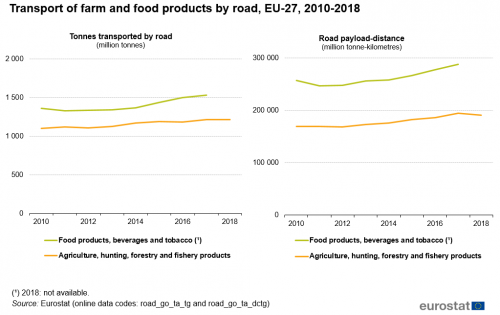
Source: Eurostat (road_go_ta_tg) and (road_go_ta_dctg)
It should be noted that these figures do not take into account the weight of products transported on EU roads by non-EU registered trucks nor by trucks smaller than the 3.5 tonnes loading capacity. This is important to note in the EU-border countries, as a part of international transport is not covered by these statistics.
A unit of measure of freight transport is the tonne-kilometre (tkm). This represents the transport of one tonne of goods by a given transport mode over a distance of one kilometre. For the purposes of this analysis, this measurement is referred to as a ‘payload-distance’. Agriculture, hunting, forestry and fishery products were transported by EU-registered trucks, with a loading capacity above 3.5 tonnes, for a payload-distance of 195 billion tonne-kilometres in 2017 and 191 billion tonne-kilometres in 2018. Food products, beverages and tobacco were transported for a further 288 billion tonne-kilometres in 2017. To put this in some context, this was the equivalent of an average distance of 176 km for every tonne of such combined goods transported by road.
A wide range of products are transported by EU-registered trucks but the payload-distance by road of the combined product groups of agriculture, hunting, forestry and fishery products and food products, beverages and tobacco was more than that of any other product group in 2017. These combined groups of goods accounted for 27.5 % of the payload-distance of all road freight transport on EU-registered trucks and 20.8 % of all the road freight tonnes in 2017.
A large majority (85.4 % of the goods in tonnes, 2017) of agriculture, hunting, forestry and fisheries products transported by EU-registered trucks were carried over distances of less than 300 km. This was also the case (79.8 %) for food products, beverages and tobacco products. Indeed, in both cases a majority (68.1 % and 58.9 % respectively) of these products were transported over distances of less than 150 km. In large part this reflects the perishable nature of many (particularly fresh) agricultural and food products as well as their widespread availability from regional producers.
National road freight transport, which is carried out between two places located in the same country by a vehicle registered in that country, was the largest component of the road freight transport of agricultural, hunting, forestry and fishery products, and of food products in the EU, as was the case for other products. National transport dominated road freight transport of agriculture, hunting, forestry and fishery products in all Member States. The highest shares (above 99 %) were on island Member States like Cyprus and Ireland and those with strong international sea transport links like Finland and Sweden. Only in a few Member States, like the Netherlands and Belgium, where there are important cargo ports, as well as Luxembourg, Slovenia, Hungary and Slovakia was the share of international freight transport of agriculture, hunting, forestry and fisheries products above 15 %.
Consumer stage
There is a wide variety of food and drinks available to EU citizens. Purchases often reflect local, regional and national cuisine and form part of the national cultural identity of a Member State. There are also considerable differences in the proportion of household income spent on food and beverage products.
Food and beverages (including catering services) accounted for a combined 21.5 % of the final consumption expenditure of households, on average, across the EU-27 in 2018. Of this total, an average 11.8 % was spent on food, 6.8 % on catering services, 1.6 % on alcoholic beverages and 1.2 % on non-alcoholic beverages. However, these shares varied considerably among the Member States. The highest overall proportions were in Romania and Estonia (each at 30.9 %) and lowest in Luxembourg (17.3 %) and Germany (16.6 %).
For most people, food and beverages are essential items of expenditure, although for many people there is food poverty. About one in every ten (an estimated 11.9 %) people over the age of 16 years had either some or a severe inability to afford a meal with meat, chicken, fish, or vegetarian equivalent in 2018. The proportion was highest (13.8 %) in the age range of people aged 55 to 64 years old.
Poverty in the EU prevents many people from having nutritious meals. However, as average incomes rise, there is often product substitution for better quality products and a higher consumption of catering services. The average expenditure on food and beverages as a proportion of income tends to decline as average income rises.
Among socio-economic groups across the EU, the highest proportion of household expenditure spent on food was among the unemployed (17.2 %) and the retired (15.9 %) and the lowest among non-manual workers (12.6 %). The highest proportion of household expenditure spent on catering services was for non-manual workers (5.4 %). There was relatively little variation in the proportion of household consumption expenditure spent on alcoholic beverages between the various socio-economic groups (between 0.9 and 1.1 percentage points).
So what foods and drinks are people spending money on? Among food categories, meat accounted for the largest share of household consumption expenditure in each of the Member States (3.3 % on average across the EU in 2015, but reaching a high of 7.8 % in Romania).
The European Commission has had a number of initiatives that promote healthy and sustainable diets. Among these was the 2007 initiative on nutrition, overweight and obesity-related health issues[5] which encompassed initiatives on food labelling, school fruit and milk schemes, on sport and research projects. Among other objectives were: the avoidance of nutritional deficiencies and of direct health problems of being overweight; the promotion of safe and sustainable food; a reduction in food waste; and, improved animal welfare. The direct health problems related to being overweight or obese also have an economic impact as costs related to treatments for weight-related illnesses. Obesity causes a range of chronic diseases, including diabetes, cancers and heart disease. The body mass index (BMI) is defined as a person's weight in kilograms divided by the square of their height.
One half of the EU-27’s population (51.8 %) was classified as overweight in 2017. A little over one-third (36.9 %) of the EU population was pre-obese (with a BMI between 25 but less than 30) with a further 14.9 % being obese (with a BMI greater than 30) in 2017. These proportions appear to be rising. This was the case for the overwhelming majority of the Member States for which data are available from 2008. In some Member States, the proportion of their population that was overweight rose significantly; for example, in Bulgaria it rose from 50.8 % in 2008 to an estimated 59.5 % and in Romania from 50.3 % in 2008 to an estimated 62.9 % in 2017 (the highest rate among the Member States).
The proportion of pre-obese and obese persons generally varies with age and rises to a peak between the ages of 55 and 74 years of age, before dropping off again. A little more than one fifth (22.1 % in 2014) of young adults across the EU aged 18 to 24 years were pre-obese or obese. However, nearer two-thirds (66.4 % in 2014) of adults aged between 65 and 74 years were pre-obese or obese.
These data underline the policy interest in promoting healthy, sustainable diets across generations and sustainable food consumption.
Related datasets: Consumtion expenditure,socio-economic structure and obesity.
Generation of waste
The households of the EU-27 generated 187.4 million tonnes of waste in 2016, equivalent to 8.3 % of all the waste generated by economic activities and households. This waste includes plastics, metals and clothing among much more. Within total household waste, 28.3 million tonnes of animal and mixed food waste and vegetal waste was generated in 2016.
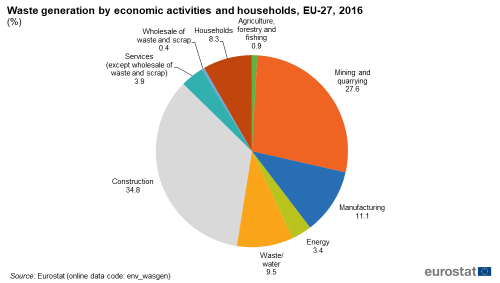
(%)
Source: Eurostat (env_wasgen)
The quantity of animal and mixed food waste and vegetal waste generated by households doubled (+104.1 %) in the period between 2004 and 2016. This highlights the task ahead in tackling food waste within the EU.
Related dataset: Generation of waste.
Conclusion
Efforts to tackle waste, weight issues and citizens’ health, whilst ensuring food security and mitigating climate change will have an impact across the food chain. It has implications for what farmers and fisheries produce and how they produce it. It has implications for how food is packaged, labelled and transported. It has implications on what is traded with partners around the world. And it also has implications for the food that we eat and what we drink. Shedding some light on the current situation in the chain is the first step in this new strategy.
Source data for tables and graphs
Data sources
Farm Structure Survey
Almost all of the statistics for farms and farmers were drawn from the Farm Structure Survey for 2016. The Farm Structure Survey (FSS) provides a wide range of information on agricultural holdings, including detailed data on farm labour force characteristics. The FSS is carried out in the form of an agricultural census every 10 years and as a sample survey every 3 years.
Organic farming
Data are collected annually and provided by the EU Member States and Iceland, Norway, Switzerland, Turkey, North Macedonia, Montenegro and Serbia on the basis of a harmonised questionnaire. Data in this annual collection originate from the administrative data of national entities in charge of the certification of operators involved in the organic sector. Up until the reference year 2007, data provision was voluntary. From reference year 2008 onwards, data have had to be delivered following Commission Regulation (EC) No 889/2008, implementing Council Regulation (EC) No 834/2007.
Crop statistics
Statistics on crop products are collected under Regulation (EC) No 543/2009 and obtained by sample surveys, supplemented by administrative data and estimates based on expert observations. The sources vary from one EU Member State to another because of national conditions and statistical practices. National Statistical Institutes or Ministries of Agriculture are responsible for data collection in accordance with EU Regulations. The finalised data sent to Eurostat are as harmonised as possible. Eurostat is responsible for establishing EU aggregates. The statistics that are collected on agricultural products relate to more than 100 individual crop products.
Livestock and meat statistics
Livestock and meat statistics are collected by EU Member States under Regulation (EC) No 1165/2008, which covers bovine, pig, sheep and goat livestock; slaughtering statistics on bovine animals, pigs, sheep, goats and poultry; and production forecasts for beef, veal, pig meat, sheep meat and goat meat. Livestock surveys cover sufficient agricultural holdings to account for at least 95 % of the national livestock population, as determined by the last survey on the structure of agricultural holdings. Bovine and pig livestock statistics are produced twice a year, with reference to a given day in May/ June and a given day in November/ December.
Milk and milk product statistics
Milk and milk product statistics are collected under Decision 1997/80/EC and implementing Directive 1996/16/EC. They cover farm production and the utilisation of milk, as well as the description (structure), collection and production activity of dairies. Due to the small number of dairy enterprises, national data are often subject to statistical confidentiality. Thus, providing EU totals in this context is a challenge and some of the information presented in the analysis is based on partial data for the Member States (which may exclude several countries). On the one hand, statistics from these few enterprises provide early estimates on trends. On the other, a complete overview of the dairy sector requires detailed information from farms and this means that the final figures on milk production are only available at an EU level about one year after the reference year. Dairy products are recorded in terms of weight. It is thus difficult to compare the various products (for example, fresh milk and milk powder). The volume of whole or skimmed milk used in the dairy processes provides more comparable figures.
Economic Accounts for Agriculture
The economic accounts for agriculture (EAA) are a satellite account of the European system of accounts (ESA 2010). They cover the agricultural products and services produced over the accounting period sold by agricultural units, held in stocks on farms, or used for further processing by agricultural producers. The concepts of the EAA are adapted to the particular nature of the agricultural industry: for example, the EAA includes not only the production of grapes and olives but also the production of wine and olive oil by agricultural producers, if produced from own grapes and olives. It includes information on intra unit consumption of crop products used in animal feed, as well as output accounted for by own account production of fixed capital goods and own final consumption of agricultural units. The EAA comprises a production account, a generation of income account, an entrepreneurial income account and some elements of a capital account. For the production items, EU Member States transmit to Eurostat values at basic prices, as well as their components (values at producer prices, subsidies on products, and taxes on products).
Consumption of pesticides
The data collection from reference year 2011 onwards is based on Regulation (EC) No 1185/2009 concerning statistics on pesticides, which established a common framework for the systematic production of Community statistics on sales and use of those pesticides which are plant protection products. The 'Harmonised classification of substances' classifies each active substance in a major group, category of product and chemical class. Eurostat is permitted to publish non-confidential country data at the level of major group and category of product.
Plant protection products are preparations consisting of or containing one or more active substances, in the form in which they are supplied to the user, intended to:
- protect plants or plant products against all harmful organisms or prevent the action of such organisms, in so far as such substances or preparations are not otherwise defined below;
- influence the life processes of plants, other than as a nutrient, (e.g. growth regulators);
- preserve plant products, in so far as such substances or products are not subject to special Council of Commission provisions on preservatives;
- destroy undesired plants; or
- check or prevent undesired growth of plants.
Nevertheless, there is no common definition adopted by all Member States and there can be significant differences in the range of products used in different countries, so comparability is limited. Additional information on the situation in specific countries is required for any detailed assessment. Data refer to amounts of active substances, which are the substances in a commercial product that cause the desired effect on target organisms (fungi, weeds, pests, etc.). Base data is generally in kg of active ingredient sold per year for each of the main functional categories of products ('Herbicides, haulm destructors and moss killers', 'Fungicides and bactericides', 'Insecticides and acaricides' and others).
Data on sales of pesticides cover both agricultural and non-agricultural uses.
Pesticide sales statistics are affected by confidentiality restrictions. The impact of these restrictions on the data varies according to the Member States, the type of pesticides and the year. As regards the total sales of pesticides in the EU 2011-2017, < 3 % of the volume is confidential data.
Mineral fertiliser consumption
Eurostat publishes two data sets on inorganic fertilisers: (aei_fm_usefert) and (aei_fm_manfert). The first one is collected from Member States and is an estimate of the nitrogen (N) and phosphorus (P) use in agriculture. The other data set is estimated consumption based on the sales of mineral fertiliser in the EU from Fertilizers Europe. The figures estimated by the trade association Fertilizers Europe based on sales of mineral fertiliser mostly correspond with the estimates of nitrogen and phosphorus use reported by countries although they cannot be directly compared due to methodological differences.
Gross nitrogen balance
The methodology of the nitrogen balances is described in Eurostat/OECD Nutrient Budgets handbook. The gross nitrogen balance lists all inputs and outputs into and out of the soil and calculates the gross nitrogen surplus as the difference between total inputs and total outputs. The gross nitrogen surplus per ha is derived by dividing the total gross nitrogen surplus by the reference area. The reference area of the current version of balances uploaded in Eurostat database is the UAA (utilised agricultural area). It should be noted that some countries use slightly different methodologies; Austria and Spain fall into this group. It means that the time series are comparable within the countries, but the individual values should not be compared with other countries' individual values.
Fisheries statistics
Fisheries statistics are collected by Eurostat from official national sources for the EU Member States and members of the European Economic Area (EEA). The statistics are collected using internationally agreed concepts and definitions developed by the Coordinating Working Party (CWP), comprising Eurostat and several other international organisations with responsibilities in fisheries statistics.
The European fisheries production statistics include production from catches and aquaculture. Catches refer to fishery products taken for all purposes (commercial, industrial, recreational and subsistence) by all types and classes of fishing units (including fishermen, vessels, gear, etc.). The flag of the fishing vessel is used as the primary indication of the nationality of the catch. In addition to catches, Eurostat also collects statistics on landings which relate to all fishery products (expressed as product weight) landed in the reporting country, regardless of the nationality of the vessel making the landings. Landings by vessels of the reporting country in non-EU ports and imported into the EU are to be included as well. Aquaculture production refers to the farming of aquatic (freshwater or saltwater) organisms, under controlled conditions. Aquaculture implies some form of intervention in the natural rearing process such as regular stocking, feeding and protection from predators. Farming also implies individual or corporate ownership of the stock being cultivated.
Catch statistics are submitted to Eurostat by EEA member countries in compliance with the following EU legislation:
- Regulation (EC) No 218/2009 of the European Parliament and of the Council of 11 March 2009 on the submission of nominal catch statistics by Member States fishing in the North East Atlantic (OJ L87 of 31.03.2009);
- Regulation (EC) No 217/2009 of the European Parliament and of the Council of 11 March 2009 on the submission of catch and activity statistics by Member States fishing in the North-West Atlantic (OJ L87 of 31.03.2009);
- Regulation (EC) No 216/2009 of the European Parliament and of the Council of 11 March 2009 on the submission of nominal catch statistics by Member States fishing in certain areas other than those of the North Atlantic (OJ L87 of 31.03.2009, p.1).
The statistics are reported as the live weight equivalent of the landings (in other words, the landed weight of a product to which an appropriate conversion factor has been applied). Therefore excluded are quantities of fishery products which are caught but not landed. For the landings statistics, each country reports annual data on the quantities and values of fishery products landed in its ports under the terms of Regulation (EC) No 1921/2006 of 18 December 2006 on the submission of statistical data on landings of fishery products in EU Member States and repealing Council Regulation (EEC) No 1382/91 (OJ L403 of 30 December 2006). For aquaculture statistics, the national authorities submit aquaculture production statistics to Eurostat under the terms of Regulation (EC) No 762/2008 of 9 July 2008 on the submission by Member States of statistics on aquaculture and repealing Council Regulation (EC) No 788/96 (OJ L218 of 13.08.2008).
Concerning the fishing fleet, statistics for the EU Member States are derived from the Community Fishing Fleet Register maintained by the European Commission’s Directorate-General for Maritime Affairs and Fisheries. Statistics for Iceland and Norway are compiled from fleet files submitted by the national authorities.
Generation of waste
In order to monitor the implementation of waste policy, in particular compliance with the principles of recovery and safe disposal, reliable statistics on the production and management of waste from businesses and private households are required. In 2002, Regulation (EC) No 2150/2002 on waste statistics was adopted, creating a framework for harmonised Community statistics in this field. Starting with reference year 2004, the Regulation requires EU Member States to provide data on the generation, recovery and disposal of waste every two years. Data on waste generation and treatment are currently available for even reference years from 2004 to 2016.
Structural business statistics (SBS)
Structural business statistics describe the structure, conduct and performance of economic activities, down to the most detailed activity level (several hundred economic sectors). SBS are transmitted annually by the EU Member States on the basis of a legal obligation from 1995 onwards. SBS covers all activities of the business economy with the exception of agricultural activities and personal services and the data are provided by all EU Member States, Norway and Switzerland, some candidate and potential candidate countries. The data are collected by domain of activity: Annex I - Services, Annex II - Industry, Annex III - Trade and Annex IV- Construction and by datasets. Each annex contains several datasets as indicated in the SBS Regulation. The majority of the data is collected by National Statistical Institutes (NSIs) by means of statistical surveys, business registers or from various administrative sources. Regulatory or controlling national offices for financial institutions or central banks often provide the information required for the financial sector (NACE Rev 2 Section K / NACE Rev 1.1 Section J). Member States apply various statistical methods, according to the data source, such as grossing up, model based estimation or different forms of imputation, to ensure the quality of SBSs produced.
PRODCOM statistics
PRODCOM statistics provide detailed information on the physical volume of production sold during the survey period, the value of production sold during the survey period, and for some products, the volume of total production during the survey period. The PRODCOM survey is based on the PRODCOM List, consisting of about 3 900 products. The 8-digit codes used in the List are based on the 6-digit CPA headings and hence the 4-digit NACE rev 1.1. From 2008 onwards the PRODCOM code is linked to CPA 2008 and NACE Rev. 2. The link to NACE enables the NSIs to use the Business Register to identify the enterprises likely to be manufacturing the product. The PRODCOM List is revised every year.
Transport statistics
Data on the carriage of goods by roads are derived from micro-data collected in the framework of Regulation (EU) No 70/2012 of the European Parliament and of the Council on statistical returns in respect of the carriage of goods by road. The figures are aggregated on the basis of sample surveys carried out by the reporting countries. The data cover tonnes, tonne-kilometres, vehicle-kilometres and numbers of journeys. Road freight transport statistics are reported by Member States for vehicles registered in their country. Inland waterway transport statistics provide information on the volume and performance of freight transport on EU inland waterway network. They are reported on the basis of the "territoriality principle" which means that each country reports the loading, unloading and movements of goods that take place on its national territory, irrespective of country of origins of undertakings or place of first loading and final unloading.
Trade statistics
EU data comes from Eurostat’s COMEXT database. COMEXT is the Eurostat reference database for international trade in goods. It provides access not only to both recent and historical data from the EU Member States but also to statistics of a significant number of non-EU countries. International trade aggregated and detailed statistics disseminated from Eurostat website are compiled from COMEXT data according to a monthly process. Because COMEXT is updated on a daily basis, data published on the website may differ from data stored in COMEXT in case of recent revisions.
In this article, agricultural products are classified according to the sub-headings of the Combined Nomenclature (CN), based on the international classification known as the Harmonized commodity description and coding system (HS) administered by the World Customs Organization. The 24 chapters (2-digit codes) of agricultural products in the CN nomenclature are grouped into 3 major types: animal, vegetable and foodstuff products. Chapter 15 (animal or vegetable fats and oils and their cleavage products; prepared edible fats; animal or vegetable waxes) is included in vegetables.
Final consumption expenditure
Eurostat collects data on household final consumption expenditure according to the international Classification of individual consumption by purpose (COICOP) in the framework of ESA2010. The transmission requirements for each dataset are defined in ESA 2010 transmission programme. For COICOP data these are t+9 months after the reference period.
Household consumption expenditure is classified by consumption purpose according to the COICOP classification (Classification Of Individual COnsumption by Purpose, see also Commission Regulation (EC) No 113/2002 of 23 January 2002). Relevant COICOP categories at three-digit level are as follows:
- P010 - Food and non-alcoholic beverages
- P011 - Food
- P012 - Non-alcoholic beverages
- P020 - Alcoholic beverages, tobacco and narcotics
- P021 - Alcoholic beverages
- P111 - Catering services
Body Mass Index (BMI) statistics
The European health interview survey (EHIS) is the source of information for BMI statistics. It aims to provide harmonised statistics across the EU Member States in relation to the respondents’ health status, lifestyle (health determinants) and their use of healthcare services. The body mass index (BMI) is a measure of a person’s weight relative to their height that links fairly well with body fat. The BMI is accepted as the most useful measure of obesity for adults (those aged 18 years and over) when only weight and height data are available. It is calculated as a person’s weight (in kilograms) divided by the square of his or her height (in metres). BMI = weight (kg) / height (m²)
The following subdivision (according to the WHO) is used to classify results for the BMI:
- < 18.50: underweight;
- 18.50 – < 25.00: normal range;
- >=25.00: overweight;
- >= 30.00: obese.
Context
The Farm to Fork strategy for a fair, healthy and environmentally-friendly food system is a key component of the European Green Deal.
It has five key, strategic objectives:
- (i) Ensure sustainable food production
- This includes efforts to: strengthen the efforts of farmers and fishermen to tackle climate change, protect the environment and preserve biodiversity; reduce significantly the use of and dependency on chemical pesticides, fertilisers and antibiotics; further develop organic farming; further support the livelihood of farmers and fishermen in transition.
- (ii) Stimulate sustainable food processing and downstream practices
- This includes efforts to: influence consumers’ dietary choices; revise marketing standards; establish nutrient profiles; improve food packaging.
- (iii) Promote sustainable food consumption
- This includes efforts to: reverse the rise in overweight and obesity rates across the EU; empower consumers with better food labelling; set minimum, mandatory criteria for sustainable food procurement.
- (iv) Reduce food loss and waste
- This includes efforts to: reduce food loss across the supply chain; improve the recovery of nutrients and secondary raw materials; strengthen the bioeconomy, waste management and renewable energy.
- (v) Combat food fraud along the supply chain
- This includes efforts to: improve food traceability and alerts.
Direct access to
<seealso>
- All articles on agriculture
- Agri-environmental indicators
- Fisheries
- Waste
- Structural business statistics
- Transport
Legislation
Notes
- ↑ In an accounting context, an industry is a branch of economic activity. The term 'agricultural industry' is used to describe the branch of agricultural production but it should not be understood as inferring that agriculture is industrialised or that it is about the processing of raw materials.
- ↑ OECD (2019), Accelerating Climate Action: Refocusing policies through a Well-being lens.
- ↑ Food and Agriculture Organization of the United Nations (FAO) major areas 21, 27, 34, 37, 41, 47, 51.
- ↑ For further information see the European Commission’s Common Fisheries Policy (CFP) website.
- ↑ For more information see here.
